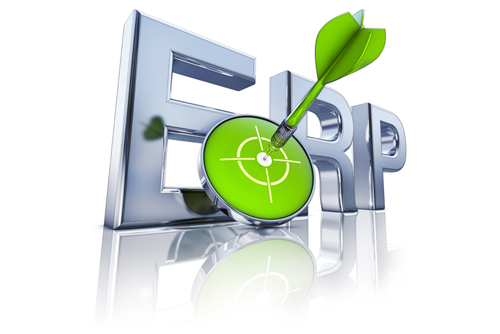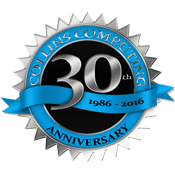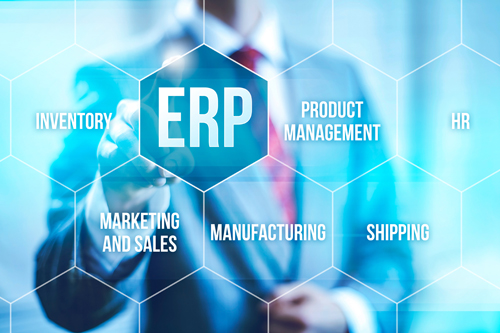Moving ERP systems is no easy task, and which system to move to is not…

6 Things You Must Know About New SaaS ERP (And Why It’s the Future)
In July of this year, a large ERP provider proclaimed that “ERP is dead” when they announced their soon-to-be-developed online “bookkeeping” product. However, ERP is far from dead—in fact, it’s not just alive, but evolving and thriving!
Since the 1990’s, when the term “Enterprise Resource Planning” (ERP) was introduced, ERP solutions have reinvented themselves several times—and right now we are in the midst of another reinvention.
If you think ERP is just bookkeeping or accountancy, you’re missing the whole point. ERP is the planning and control system that spans all vital business functions. Modern ERP systems let you visualize what is happening and improve decision-making across all your resources, including people, material, finished goods, and machinery as well as supplier shipments and customer orders.
We’re talking about TRULY integrated and up-to-the-minute accurate resource forecasting and control. You can’t get that with just Customer Relationship Management (CRM), bookkeeping and social media. There are thousands of midsize and larger businesses that are reaping the benefits of control and planning that ERP provides.
The heart of ERP is beating strong for these six reasons:
1. Cloud
The “legacy” (think old) ERP systems in use today requiring fat clients and multiple servers are becoming obsolete, largely due to the substantial hardware and IT staff expense and inability to adapt to change. It is true that legacy ERP systems are approaching their end of useful life.
But, it’s also true that the new generation of ERP doesn’t require you to provide hardware, software infrastructure, or staff; instead, it uses the Cloud. Two recent studies show that manufacturers seeking to improve their business processes are more interested in a cloud option than an on-premises deployment.
Why? Because the benefits are significant. Aberdeen Group’s 2014 Business Management and ERP Benchmark Survey found that best-in-class mid-market organizations are over twice as likely to have implemented ERP in the cloud.
Cloud ERP can be hosted at a location of your choice or be Software as a Service (SaaS). True cloud SaaS ERP is the preferred choice for modern ERP systems.
2. Device Flexibility
True cloud SaaS ERP runs anywhere, anytime, on any device with a browser. It’s that simple. This is especially true of modern systems that are built with responsive design to run on the user’s preferred device.
On the other hand, legacy ERP must be maintained on your site, takes significant time to train users on a non-intuitive system, and is limited in scope and flexibility. SaaS ERP is easily adaptable and can be deployed to a new user in minutes, anywhere in the world.
Business is global. ERP should be global, too. click to tweet this
3. Security
6-things-you-must-know-about-new-erp-and-why-its-the-future-body2
If you have a legacy ERP, you are storing your data on servers that you are responsible for backing up and protecting. Physical data is difficult to guard against theft because hacker knows EXACTLY where your data is stored.
But when your data is in the cloud, it is protected by sophisticated security that makes it nearly impossible to steal. It’s the difference between keeping your valuables in a Swiss safety deposit box or in a shoebox under your bed.
You don’t need the extra worry that your secure information might be at risk. You need to be absolutely sure that it’s safe.
4. Customization
If your business has any unique needs, you’ll be excited about how flexible SaaS ERP is.
Legacy ERP is rigid, requiring a programmer to make even basic changes.
SaaS ERP systems are flexible and tailorable to the unique needs of the user (that’s you!). You don’t have to be a programmer to make changes—even sophisticated changes—to your system as you need them.
If you’re a distributor or manufacturer, you take orders, work with suppliers, and manage your warehouse. ERP will help with all of those things, plus, it tracks the history of your product from where you bought it to where you shipped it.
Your business changes over time. SaaS ERP changes with you. click to tweet this
5. Integration
6-things-you-must-know-about-new-erp-and-why-its-the-future-body3
SaaS ERP also keeps you from having to roll out updates for all your different devices or systems once you’ve made a change.
With the old way, integration to other unique and vital systems required extensive programming. If one or two of the systems were upgraded, even a little bit, it required additional programming and testing.
Why pay for all that time and effort? With SaaS ERP, web services make integration simple and fast, and you have control over when you schedule your updates.
Remember the “anywhere, anytime, any device with a browser” promise? SaaS ERP integration is good for all of that, too.
6. Licensing Flexibility
Unfortunately, most ERP software is licensed by the number of users. Those old systems require you to spend more money to add users, and you might have to upgrade your servers, too. This limits your ability to significantly collaborate with your customers, subcontractors or suppliers.
In contrast, Acumatica’s Cloud ERP doesn’t charge by the number of users, but by the resources you require. Think in terms of any other service, like power or water. In Cloud ERP it is required functionality, computing power, and data storage. You can easily scale up or down according to the needs of your business.
You pay for the resources you need, not the number of people who need access to your data. After all, ERP is about efficiently managing your resources.
Conclusion
The “ERP is dead” angle surfaces every few years.
Sure, the kind of ERP that is rigid, expensive, and unwieldy might be going the way of the dinosaur, but the benefits of true Cloud SaaS ERP are real and are not bound for extinction anytime soon.
ERP isn’t nearly dead; turns out, it’s just evolved.
by Ray Rebello is Acumatica’s Director of Product Marketing.
6 Things You Must Know About New SaaS ERP (And Why It’s the Future)
For Over 30 years, Collins Computing has been selling and supporting accounting software solutions. We’re experts in Microsoft Dynamics GP and Acumatica Cloud ERP.
Exclusively focused on implementing the best ERP solutions to the mid-market. Our success has been proven with hundreds of Microsoft Dynamics GP ERP and Acumatica Cloud ERP installations and implementations throughout Southern California (Los Angeles County, Orange County, San Diego County, Riverside County, Ventura County, and San Bernardino County), Utah (Salt Lake County and Utah County), Phoenix Arizona and Oregon.
Our staff is all about excellence and customer satisfaction. We can handle all your needs, from implementation, customization, and ongoing support. With our team working for you, you will get access to not only the best ERP solutions on the market but the best onsite and offsite support and training.
To learn more about how Collins Computing can help bring your company up to date on the latest Cloud ERP technology and systems, Contact our Expert ERP Team Today









